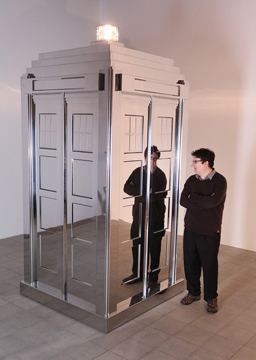
Mark Wallinger with his piece "Time and Relative Dimensions in Space" at the Hayward Gallery, 2009
Pity the poor curator, scapegoat of the contemporary art sceptic. It’s hard not to feel at least a little sorry for Nicholas Bourriaud, curator of Tate Britain’s Altermodern, who has borne the brunt of the sometimes vituperative criticism the show has received from the majority of art critics in British daily newspapers. Take, for example, Waldemar Januszczak of the Times, who lays the blame for his perceived failure of the exhibition squarely at the puffed-up status curators of contemporary art have acquired in recent years:
The second question that kept bundling itself into my mind was: what’s the best way to murder a curator? Curators are the art world’s biggest contemporary pests. The Tate is overrun with them. Twenty years ago, they barely existed. Now every ambitious display of modern art is a curator’s personal handiwork. The Tate Triennial is the achievement of a curatorial dunce called Nicolas Bourriaud…
Janucszak’s is by no means a lone voice, although he is certainly the only advocate of actual bodily harm. Unquestionably, curatorship has undergone an enormous transformation over the last twenty years. Traditionally, in what was often a literal reading of the word’s Latin root curare (to take care of, to attend to), curators were of a piece with librarians: tweedy, esoteric, averse to direct sunlight. Curators squirreled away in regional museums writing letters to the papers when an Etruscan vase was misdated in a news story, living caveats against a kind of intellectual hedonism. Nowadays it’s not uncommon for a curator’s name to be foregrounded in exhibition literature and sometimes announced in forty-point Letraset at an exhibition’s starting point (I’ve seen this many times, and always with a sinking feeling). It’s a great example of a profession’s lack of clear definition in the public eye being inversely proportional to the amount of flatulent endorsement it acquires from those who should know better.
The word ‘curate’ has become so debased from its original meaning that you can now hang an exhibition in a small commercial gallery, write a 300-word press release and claim to have ‘curated’ it. DJ’s now talk about ‘curating’ musical sets; rock festivals are no longer organized, they’re ‘curated.’ So divorced has the term become from any notion of scholarship or care that it’s become another empty contemporary art signifier like ‘sourced’ or ‘practice’ or ‘discourse’ that is barely on nodding terms with its original meaning, and exists merely to pad out skimpy press releases or grant applications. The late, great George Carlin would have loved all this: “People add words when they want things to sound more important than they really are” (from Jammin’ in New York, 1992) is a good summary of the contemporary art world’s, er, liberal approach to the English language.
But great curatorship hides itself, or, put another way, the first rule of curating is you don’t talk about curating. Mark Wallinger’s current exhibition at the Hayward Gallery, The Russian Linesman (the title derives from the referee in the 1966 Germany-England World Cup soccer game whose decision—still kind of hotly contested between the two nations—is seen as instrumental in England’s victory), is not only an extraordinary collection of diverse objects but is a proposition for the future of curatorship as a whole.
Wallinger places a variety of historically and artistically anachronistic objects alongside each other in such a way that each enhances the other. So a string piece by Fred Sandback (woefully undershown in European galleries) is installed opposite a copy of Albrecht Durer’s The Painter’s Manual (1525), with its woodcuts illustrating the use of string and frames to create convincing linear perspective. Likewise, a George Stubbs drawing of a human skeleton crouching ape-style sits cheek-by-jowl with a 1665 Robert Hooke drawing of a flea, crouched in a similar pose; a suite of Muybridges riffs on the theme, so that a telescoped historical frame lets meaning flicker between objects, without ever cramping the pieces’ style, or subordinating their weird power to a half-baked curatorial whim. Wallinger’s show has the feel of a Renaissance Wunderkammer, plucking liberally from news footage (the show is bookended by Aernout Mik’s video cast-offs of footage from the Balkans and CNN’s early morning helicopter shots of Philippe Petit’s tightrope stretched between the Twin Towers in 1974) as well as literary history (a Blake illustration and a Durer woodcut of a scene from Revelations are placed beside a speaker playing James Joyce’s own sonorous reading of a passage from Finnegan’s Wake).
What is elucidated in Wallinger’s discreet, diverse, and intellectually enriching piece of magpie curatorship is the force that thoughtfully-placed objects can acquire when treated respectfully, rather than preciously or in a spirit of theoretical illustration. In Wallinger’s hands, a curator is a kind of archaeologist, taking leaps of historical imagination while regarding the things made by people as the strange and magnetizing things they often can be. This approach feels like a plan, an escape route from curatorship’s linguistic cul-de-sac, by which the role of the curator as facilitator of empathetic engagement with the debris of the past and present can be reclaimed, tweed notwithstanding.




Pingback: No No No 3/2/09 « To Fear It Is To Know It
Pingback: Ben Street on Curating : Bad at Sports
Pingback: Curating 2.0, A Moveable Feast | Bryan Formhals
Pingback: The Yuk Factor « Good Morning, Andrew
Pingback: Humre… « Dweller On The Threshold
Pingback: Roundup | 12th Press
Pingback: Letter from London: Hell Is Other People | Art21 Blog